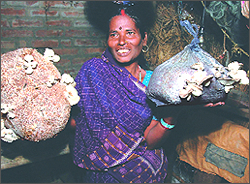I hope I can finish posting this before the battery runs out on my laptop. It’s been one long power cut after another for the past couple of days and the one we’re experiencing at the moment started more than three hours back. Anyway, I thought this piece in EurekAlert really interesting and I couldn’t wait to blog about it. There’s this rare endemic plant on Mauritius called Trochetia blackburniana, you see, and it happens to be pollinated by the equally endemic gecko Phelsuma cepediana. But this is a day gecko, which means that to avoid predators they have to spend a lot of time hiding, and their favourite place for doing that is among the spiky leaves of Pandanus shrubs. Now, I’m not sure about Mauritius, but in lots of other places around the Indian and Pacific Oceans, Pandanus is a really useful plant: the fruits are eaten, the leaves woven into mats, people recognize and maintain dozens of varieties etc etc. So here’s something else that Pandanus is important for: protecting the pollinators of a rare Mauritian endemic.
P.S. Incidentally, Trochetia blackburniana, which is in the Malvaceae, seems to be one of the very few species of plants with coloured nectar.
Correction: Trochetia is actually in the Sterculiaceae. Apologies. Please read the comments for more interesting stuff on this genus.
 Sometimes it is hard to keep up with the pace of news. A week ago The Indian Express ran a story about Lal Muni Devi, a poor landless woman who had made a great success of
Sometimes it is hard to keep up with the pace of news. A week ago The Indian Express ran a story about Lal Muni Devi, a poor landless woman who had made a great success of